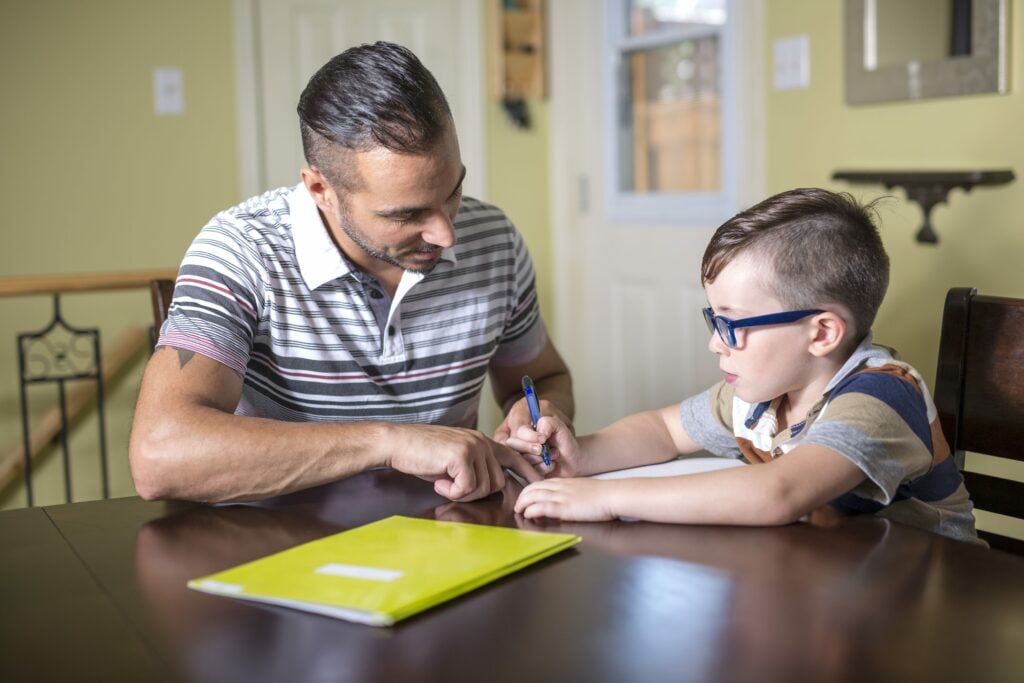Taking our anxiety back to school
Reviewed by Brooks Baer, LCPC, CMHP


My daughters’ backpacks are heavier than mine ever was. Having no car means they must walk the half-mile of dirt road from the bus stop to our home while hauling nearly 30 pounds apiece. At first I thought they were whining unnecessarily, until I casually grabbed a pack and threw it on one day. My shoulder buckled under the weight.


I can’t help but think of this as a metaphor. What kids carry to school these days are huge concerns like gun violence, public health crises, depression, anxiety, bullying. All their fears are packed up as tight as their backpacks.
When my twin girls were in kindergarten, school shootings became a recurring tragedy. As they grew up, cyberbullying and social anxiety joined the fray. Then a global pandemic hit when they were 13, and schools shut down. That year was a game changer for mental health. Depression and anxiety rates soared around the world, especially among young people.1
With each new fear, our kids’ backpacks sag a little more. How long before the weight becomes too much for them to bear? And how can we as parents help them shoulder that load?
Schedule daily or weekly check-ins
Therapist Janine Halloran, MA, LMHC, founder of Coping Skills for Kids, has been working with children and adolescents for more than 20 years. She admits that talking to kids about their mental health can be challenging, especially if you have little ones who may not be able to voice what they’re feeling.
To help start the conversation, she suggests scheduling a daily or weekly check-in where you ask your children how they feel about the school year while sharing your own feelings. This check-in can also take the form of an activity. For little kids, Halloran recommends using a game like Rose, Thorn, and Bud. Older kids can make or choose a meme that depicts their feelings about the day or a specific event.
These check-ins have many potential benefits:
- Acknowledging: Giving kids permission to feel what they feel is important, says Halloran: “You can feel excited, scared, worried, and angry all at the same time, and that’s okay.”
- Normalizing: When you share your own anxieties and emotions with your children, Halloran says, “They will see you as human.” She calls the COVID-19 pandemic a “collective trauma” and believes that framing it as a shared event will help your child feel more connected to you and possibly their peers.
- Modeling: Offer specific examples of how you manage your stress in a healthy way, says Halloran—such as “When I’m feeling anxious, I go for a long walk with the dog.” This can help give kids age-appropriate strategies for managing their own anxiety.
Focus on social and emotional learning
In the years before the pandemic, a new learning style began to appear in schools: social and emotional learning (SEL), which focuses on self-awareness and interpersonal skills. Evidence suggests that SEL not only improves academic performance, but also helps kids manage their emotions and stress.2
Halloran and other therapists who work with adolescents are strong advocates for SEL, and she says that more schools have embraced this type of curriculum since the pandemic began. If your child’s school isn’t one of them, here are some SEL resources to try at home:
- Start a journal. I bought a mother-daughter journal when my girls turned 10. Not only have we found the prompts useful, but the experience of journaling has become a shared secret between us, strengthening our bond.
- Play games where your family can share their feelings. For example, talk about what kindness looks like and ask everyone to write down or say something kind about another family member.
- Encourage socialization outside of school while still being careful with your child’s health. Set up outdoor playdates if possible, or go for neighborhood walks where your child can interact with neighbors from a safe distance. Encourage older kids to go beyond Snapchat and schedule video calls where they’re face to face with friends.
- Read aloud with or to your child. Pause and ask questions about different characters and their feelings and actions. This helps kids identify with the story and build empathy.
Give them something to look forward to
Halloran loves planning a special outing for her family in the fall. “Sometimes it’s just a simple trip to a museum, and sometimes it’s an actual vacation,” she says. The idea is to give your kids—and yourself!—something to anticipate beyond that stressful first day of school.
My girls have a friend whose family always went on vacation in late September. Her mom, Kelly, says it wasn’t intentional at first: “Honestly, we went away at that time of year because we could afford it.” (Hotel and house rental prices tend to drop significantly after Labor Day.) Kelly had planned to stop these vacations as her kids got older, but they begged her not to. “They grew to really love the trips, and it helped relax them into the school year,” she says.
Halloran understands that taking a longer vacation isn’t always possible after school starts. But there are still ways to create a moment your kids can look forward to:
- Plan a camping weekend. Camping is fun for all ages and offers benefits for the whole family.
- Visit family or friends. An affordable way to stay connected with loved ones is by going to stay with an out-of-town friend or family member who lives within driving distance.
- Take a “mental health day.” If you can take a day off work, let your kids miss a school day as well. Be sure to check in with their school about the attendance policy, of course, but more states are allowing students to miss school to tend to their mental health.3 See a movie, go out for ice cream, or do something else you all enjoy. Planning this day in advance can help combat back-to-school anxiety.
Know when to seek outside help
Remember those backpacks full of worries? How do we know when to step in and help our kids carry them?
“Any time anxiety is interfering with their regular routine, it’s time to assemble a team,” Halloran says. If your child’s anxiety has started to prevent them from going outside, showering, waking up for school, eating, or doing any of the activities they normally enjoy, that’s a red flag.
Assembling a team of superheroes
The support network you put together will be unique to your family. What matters most is that you trust each person and that they care about your child. The more members of your superhero team, the more supported your child will feel.
Your team might include:
- Grandparents or other close family
- Your child’s school counselor
- Your child’s teacher
- A therapist who works with kids or adolescents
- Your child’s pediatrician or a trusted family doctor
- A coach or someone else related to your child’s extracurricular activities
- A leader from your faith community
- A community member you trust, such as someone from your local Boys & Girls Club
By building a team of people who know and are invested in your child, Halloran says, you can help weave a safety net to catch your child if they’re struggling.
For immediate help in an emergency, call the Suicide & Crisis Lifeline at 988 or text HOME to the Crisis Text Line at 741741. Both resources are available 24/7.
Practice self-care
Our main job as parents is to care for our children, but don’t forget the timeless advice to put on your own oxygen mask first. As we send our nervous kids back to school this year, parents are also experiencing more anxiety and fear. It’s important to practice self-care so we can be our best selves when helping our kids.
To soothe your own stress, try one or more of these tactics:
- Take a walk or go to the gym.
- Find a few minutes for mindfulness or meditation.
- Build your own network by connecting with other parents, such as coworkers who also have children.
- Journal about your feelings or write about something you enjoy.
- Find a support community or a group therapy session designed for parents.
- Do any activity that brings you joy. It turns out Janine Halloran and I both love to play video games. A self-proclaimed “Nintendo gal,” Halloran finds relaxation and calm in gaming by herself and with her kids.
Trust your instincts
Halloran advises parents not to wait on creating your child’s safety net until the school alerts you to a problem. If you need help, ask for it right away. “If your parent gut knows something is off, reach out and talk to somebody,” she says.
My gut tells me there will be days when my girls bounce down the bus steps and carry their bags home as if they were helium balloons floating into the sun. And there will be days when they slump off the bus and both bags hit the dirt like bowling balls in cement.
Either way, I will be there to help carry them home.

Sources
About the author
Amye Archer, MFA, is the author of “Fat Girl, Skinny” and the coeditor of “If I Don’t Make It, I Love You: Survivors in the Aftermath of School Shootings,” and her work has appeared in Creative Nonfiction magazine, Longreads, Brevity, and more. Her podcast, “Gen X, This Is Why,” reexamines media from the ’70s and ’80s. She holds a Master of Fine Arts in creative nonfiction and lives with her husband, twin daughters, and various pets in Pennsylvania.
Related articles

Advocating for your K-12 child with disabilities
Many school districts offer resources for K-12 kids with disabilities. Learn...

Self-care for college students
Going to college is exciting, but full of new challenges. Find out how students...

How are teachers managing their mental health?
Teachers are on the front lines of supporting kids. A psychologist and educator...

Peer counseling helps students thrive
Through peer counseling, students can get mental health support from someone...
